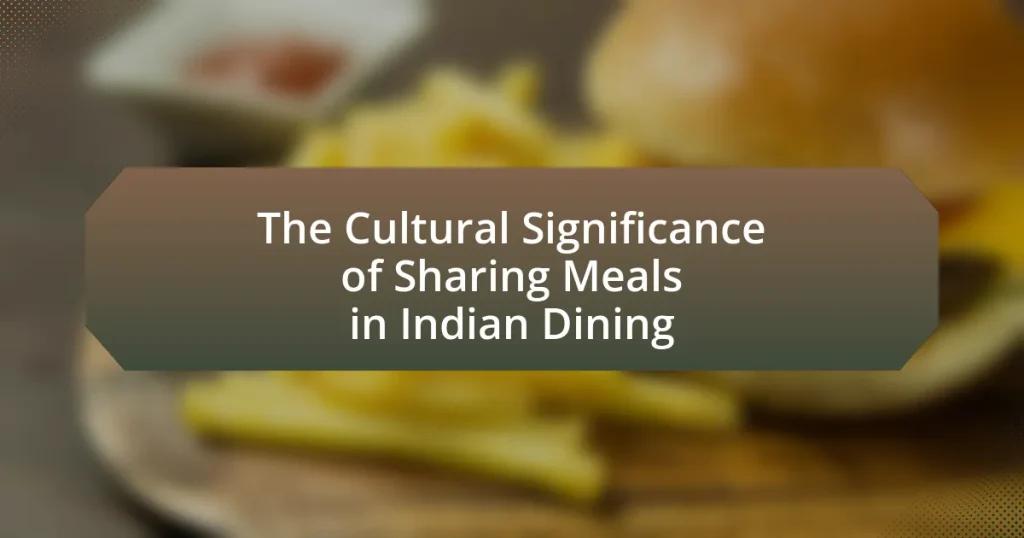The article explores the cultural significance of sharing meals in Indian dining, emphasizing its role in fostering community, hospitality, and familial bonds. It highlights how communal dining practices are rooted in historical traditions and values, such as “Atithi Devo Bhava,” which underscores the importance of treating guests with respect. The article examines the influence of family dynamics, regional variations, and religious practices on meal sharing, as well as the psychological benefits and social cohesion that arise from these communal experiences. Additionally, it addresses the impact of globalization and contemporary lifestyles on traditional meal sharing practices, offering best practices to enhance the quality of shared meals in Indian culture.

What is the cultural significance of sharing meals in Indian dining?
Sharing meals in Indian dining holds profound cultural significance as it symbolizes community, hospitality, and familial bonds. In Indian culture, meals are often communal experiences where food is served on a shared platter, fostering a sense of togetherness and unity among participants. This practice is rooted in the belief that sharing food strengthens relationships and promotes social harmony.
Historically, the tradition of sharing meals can be traced back to ancient Indian texts, which emphasize the importance of hospitality (Atithi Devo Bhava) and the idea that food is a gift to be shared. Additionally, during festivals and celebrations, communal dining reinforces cultural identity and collective joy, highlighting the role of food in cultural rituals and social gatherings.
How does sharing meals reflect Indian values and traditions?
Sharing meals in India reflects core values of community, hospitality, and familial bonds. In Indian culture, meals are often communal experiences that emphasize togetherness and social harmony. The practice of sharing food symbolizes the importance of relationships and the belief that food is a gift meant to be enjoyed collectively. For instance, during festivals and family gatherings, it is customary to serve food to guests first, showcasing the value placed on hospitality, which is deeply rooted in Indian traditions. Additionally, the concept of “Atithi Devo Bhava,” meaning “the guest is God,” further illustrates the significance of sharing meals as a way to honor and respect others. This cultural practice reinforces social ties and fosters a sense of belonging within communities.
What role does hospitality play in Indian meal sharing?
Hospitality is central to Indian meal sharing, as it embodies the cultural value of treating guests with utmost respect and generosity. In Indian tradition, sharing a meal is not merely about food; it is a ritual that signifies warmth, community, and connection. The practice of offering food to guests is deeply rooted in the belief that “Atithi Devo Bhava,” meaning “the guest is God,” which highlights the importance of hospitality in Indian culture. This principle encourages hosts to provide abundant and diverse dishes, ensuring that every guest feels welcomed and valued. The act of sharing meals fosters social bonds and reinforces familial and communal ties, making hospitality a vital aspect of the Indian dining experience.
How do family dynamics influence meal sharing practices?
Family dynamics significantly influence meal sharing practices by determining the roles, responsibilities, and interactions among family members during meals. In Indian culture, for instance, hierarchical structures often dictate who prepares, serves, and consumes food, impacting the communal aspect of dining. Research indicates that families with strong intergenerational ties tend to engage in more frequent meal sharing, fostering a sense of belonging and cultural continuity. A study published in the Journal of Family Psychology highlights that families who prioritize shared meals report improved communication and emotional bonding, reinforcing the importance of family dynamics in shaping these practices.
Why is communal dining important in Indian culture?
Communal dining is important in Indian culture because it fosters social bonds and reinforces community ties. In India, meals are often shared among family and friends, symbolizing unity and togetherness. This practice is rooted in the belief that sharing food enhances relationships and promotes harmony. For instance, traditional festivals and family gatherings typically feature communal meals, where diverse dishes are served, reflecting the country’s rich culinary heritage. This not only allows for the sharing of flavors but also encourages conversations and strengthens interpersonal connections, making communal dining a vital aspect of Indian cultural identity.
What are the historical roots of communal dining in India?
The historical roots of communal dining in India can be traced back to ancient traditions and cultural practices that emphasize community and hospitality. In ancient Indian society, meals were often shared among family and guests, reflecting the values of togetherness and social bonding. Texts like the Manusmriti highlight the importance of sharing food as a means of fostering relationships and community ties. Additionally, religious practices, such as the concept of ‘langar’ in Sikhism, institutionalized communal dining, where free meals are served to all, regardless of background, reinforcing the idea of equality and unity. These practices have evolved over centuries, deeply embedding communal dining into the social fabric of Indian culture.
How does communal dining foster social bonds among participants?
Communal dining fosters social bonds among participants by creating an environment that encourages interaction and shared experiences. When individuals share a meal, they engage in conversation, collaborate in food preparation, and participate in rituals that strengthen their connections. Research indicates that shared meals can enhance feelings of belonging and community, as evidenced by a study published in the Journal of Social and Personal Relationships, which found that communal dining significantly increased participants’ sense of social support and cohesion. This collective experience not only promotes communication but also reinforces cultural traditions, making communal dining a vital aspect of social bonding in various cultures, including Indian dining practices.
What are the various contexts in which meals are shared in India?
Meals in India are shared in various contexts, including family gatherings, religious ceremonies, festivals, and social events. Family gatherings often involve sharing traditional dishes, reinforcing familial bonds and cultural heritage. Religious ceremonies, such as weddings and pujas, typically feature communal meals, symbolizing unity and devotion. Festivals like Diwali and Eid are celebrated with feasts that bring communities together, highlighting the importance of sharing and generosity. Social events, including parties and community functions, also emphasize meal sharing as a means of hospitality and connection among individuals. These contexts reflect the deep-rooted cultural significance of communal dining in India, where sharing food fosters relationships and strengthens social ties.
How do festivals and celebrations influence meal sharing?
Festivals and celebrations significantly enhance meal sharing by fostering communal bonds and cultural traditions. During these events, families and communities come together to prepare and share traditional dishes, reinforcing social ties and cultural identity. For instance, during Diwali, families often prepare large quantities of sweets and savory dishes to share with neighbors and friends, symbolizing goodwill and unity. This practice not only strengthens relationships but also preserves culinary heritage, as recipes and cooking techniques are passed down through generations. The act of sharing meals during festivals serves as a vital expression of hospitality and community spirit in Indian culture.
What role do religious practices play in communal meals?
Religious practices play a crucial role in communal meals by fostering a sense of community, shared identity, and spiritual connection among participants. In Indian dining, rituals such as prayers before meals, the use of specific utensils, and the preparation of food according to religious guidelines enhance the communal experience. For instance, during festivals like Diwali, families gather to share traditional dishes, reinforcing bonds and cultural heritage. Additionally, the practice of offering food to deities before consumption, known as prasad, symbolizes gratitude and the sanctity of the meal, further deepening the communal ties among those sharing the food.

How does sharing meals impact social relationships in India?
Sharing meals significantly strengthens social relationships in India by fostering a sense of community and belonging. In Indian culture, communal dining practices, such as family meals and festive gatherings, create opportunities for bonding and interaction among family members and friends. This practice is rooted in the belief that sharing food symbolizes hospitality and goodwill, which are essential values in Indian society.
Research indicates that meals shared among individuals enhance interpersonal connections, as they provide a platform for communication and emotional exchange. For instance, a study published in the Journal of Social and Personal Relationships highlights that shared meals contribute to relationship satisfaction and cohesion among participants. Thus, the act of sharing meals in India not only nourishes the body but also cultivates deeper social ties and reinforces cultural traditions.
What are the psychological benefits of sharing meals?
Sharing meals provides significant psychological benefits, including enhanced social bonding, reduced feelings of loneliness, and improved mental well-being. Engaging in communal dining fosters a sense of belonging and connection among individuals, which is crucial for emotional health. Research indicates that shared meals can lead to increased feelings of happiness and satisfaction, as they create opportunities for meaningful conversations and interactions. A study published in the journal “Appetite” found that individuals who regularly share meals report lower levels of stress and anxiety, highlighting the positive impact of communal eating on mental health.
How does sharing meals enhance communication among individuals?
Sharing meals enhances communication among individuals by fostering a relaxed environment that encourages conversation and connection. When people share food, they engage in a communal experience that promotes openness and trust, allowing for more meaningful interactions. Research indicates that shared meals can lead to improved social bonds and increased feelings of belonging, as evidenced by studies showing that families who dine together regularly report stronger relationships and better communication skills. This cultural practice is particularly significant in Indian dining, where meals are often communal, reinforcing social ties and facilitating dialogue among participants.
What impact does meal sharing have on community cohesion?
Meal sharing significantly enhances community cohesion by fostering social bonds and promoting a sense of belonging among participants. When individuals share meals, they engage in meaningful interactions that strengthen relationships and build trust within the community. Research indicates that communal dining experiences can lead to increased social capital, as shared meals often serve as a platform for cultural exchange and collaboration. For instance, studies have shown that in Indian dining traditions, communal meals encourage inclusivity and participation, which are essential for creating a cohesive community. This practice not only reinforces cultural identity but also facilitates the integration of diverse groups, thereby enhancing overall community solidarity.
How do different regions in India approach meal sharing?
Different regions in India approach meal sharing with unique cultural practices and traditions. In the North, communal dining is common, often seen in the form of ‘langar’ in Sikh communities, where free meals are served to all, regardless of background. In contrast, South India emphasizes sharing meals on banana leaves, symbolizing hospitality and togetherness, with dishes served in a specific order to enhance the dining experience. In the East, particularly in Bengal, sharing fish and rice during festivals highlights the importance of community and family ties. Meanwhile, in the West, particularly in Gujarat, meal sharing often includes vegetarian thalis served during celebrations, reflecting the region’s cultural values of inclusivity and generosity. These practices illustrate the diverse ways meal sharing fosters social bonds and cultural identity across India.
What are the regional variations in communal dining practices?
Regional variations in communal dining practices in India include distinct customs and rituals that reflect local cultures and traditions. For example, in Punjab, communal dining often occurs during festivals and celebrations, where large gatherings share meals on long tables, emphasizing hospitality and abundance. In contrast, in South India, communal dining typically involves serving food on banana leaves, where individuals eat together while seated on the floor, highlighting simplicity and connection to the earth. Additionally, in Gujarat, the practice of ‘thali’ dining showcases a variety of dishes served on a single platter, encouraging sharing and variety among diners. These practices are rooted in cultural significance, as communal meals foster social bonds and reinforce community ties across different regions.
How do local cuisines influence the experience of sharing meals?
Local cuisines significantly enhance the experience of sharing meals by fostering a sense of community and cultural identity. In Indian dining, for instance, traditional dishes often reflect regional ingredients and cooking methods, which encourage communal eating practices such as thali, where various dishes are served together. This not only promotes sharing but also allows individuals to experience a variety of flavors and textures in one meal, reinforcing social bonds. Studies show that meals shared in a communal setting can lead to increased feelings of belonging and satisfaction, highlighting the role of local cuisines in creating memorable dining experiences.

What are the modern implications of sharing meals in Indian dining?
Sharing meals in Indian dining fosters community, strengthens social bonds, and promotes cultural continuity. In contemporary India, this practice transcends mere sustenance, serving as a vital social ritual that reinforces familial and communal ties. Research indicates that communal dining experiences enhance interpersonal relationships and contribute to emotional well-being, as seen in studies highlighting the positive effects of shared meals on mental health and social cohesion. Furthermore, the act of sharing meals reflects and preserves traditional values, such as hospitality and inclusivity, which remain significant in modern Indian society.
How has globalization affected traditional meal sharing practices?
Globalization has significantly altered traditional meal sharing practices by introducing diverse cuisines and altering social dynamics around dining. The influx of international food options has led to a blending of culinary traditions, which can dilute the cultural significance of traditional meals. For instance, in urban areas of India, the rise of fast food chains and global dining trends has shifted communal eating from home-cooked meals to more individualistic dining experiences, impacting family bonding and cultural rituals associated with meal sharing. Studies indicate that as global influences permeate local cultures, the frequency of traditional meal sharing decreases, with families opting for convenience over cultural practices, thereby diminishing the communal aspect that is central to Indian dining traditions.
What changes have occurred in urban settings regarding meal sharing?
Urban settings have seen a significant shift towards more organized and community-focused meal sharing practices. This change is driven by the rise of technology platforms that facilitate meal sharing, such as apps and social media groups, allowing individuals to connect over shared meals. Additionally, urbanization has led to increased social isolation, prompting people to seek communal dining experiences as a way to foster connections and build community ties. Research indicates that these meal sharing initiatives not only enhance social interactions but also promote cultural exchange, as diverse culinary traditions are shared among participants.
How do contemporary lifestyles challenge traditional meal sharing?
Contemporary lifestyles challenge traditional meal sharing by prioritizing convenience and individualism over communal dining experiences. The rise of fast food, busy work schedules, and digital communication has led to a decline in family meals, with studies indicating that only 30% of families share dinner together regularly. This shift diminishes the cultural significance of meal sharing, which traditionally fosters social bonds and cultural identity in Indian dining practices. As a result, the essence of communal meals, which is integral to Indian culture, is increasingly undermined by modern habits that favor solitary eating or quick, on-the-go meals.
What best practices can enhance the experience of sharing meals?
Best practices that can enhance the experience of sharing meals include creating a welcoming atmosphere, encouraging participation in meal preparation, and fostering open communication among diners. A welcoming atmosphere can be achieved through thoughtful table settings and ambient lighting, which studies show can positively influence social interactions. Encouraging participation in meal preparation allows guests to engage with the food and each other, enhancing the communal aspect of dining. Additionally, fostering open communication, such as sharing stories or discussing the significance of the dishes, can deepen connections and enrich the dining experience, as evidenced by research indicating that shared narratives during meals strengthen social bonds.
How can individuals create a welcoming environment for communal dining?
Individuals can create a welcoming environment for communal dining by fostering inclusivity and comfort among participants. This can be achieved by arranging seating to encourage conversation, using warm lighting to create an inviting atmosphere, and providing a diverse menu that caters to various dietary preferences. Research indicates that communal dining experiences enhance social bonds and cultural exchange, as seen in Indian dining traditions where sharing meals symbolizes unity and hospitality. By incorporating these elements, individuals can enhance the communal dining experience, making it more enjoyable and meaningful for all participants.
What tips can improve the quality of shared meals in Indian culture?
To improve the quality of shared meals in Indian culture, focus on enhancing the communal experience through traditional practices and mindful preparation. Engaging in the practice of serving food in a thali, which allows for a variety of dishes to be shared, fosters a sense of togetherness. Additionally, incorporating seasonal and locally sourced ingredients not only elevates the meal’s flavor but also supports sustainable practices, as evidenced by the Indian dietary tradition that emphasizes fresh produce. Furthermore, encouraging participation in meal preparation among family members can strengthen bonds and create a more inclusive atmosphere, reflecting the cultural value placed on hospitality and togetherness in Indian dining.
